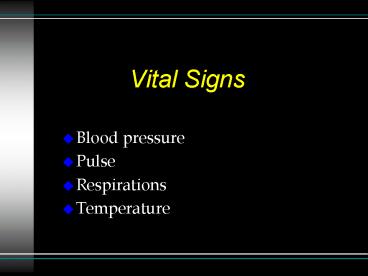Vital Signs - PowerPoint PPT Presentation
1 / 26
Title:
Vital Signs
Description:
Blood pressure Pulse Respirations Temperature will cover later... Level of consciousness pupil status breath sounds Signs & Symptoms Signs are observed or measured ... – PowerPoint PPT presentation
Number of Views:1087
Avg rating:3.0/5.0
Title: Vital Signs
1
Vital Signs
- Blood pressure
- Pulse
- Respirations
- Temperature
2
will cover later...
- Level of consciousness
- pupil status
- breath sounds
3
Signs Symptoms
- Signs are observed or measured
- Symptoms are told to you by the patient
4
Respirations
- Count number of breaths per minute
- Assess Quality
- Rhythm
- Effort
- Noise
- Assess tidal volume
- Increased
- Normal
- Decreased
5
Normal values
- Adult 12 - 20 per minute
- Child 18 - 30 per minute
- Infant 30 - 60 per minute
6
Terms
- Apnea not breathing
- Bradypnea slow breathing
- Tachypnea fast breathing
- Hypoventilation poor tidal volume
- Hyperventilation deep tidal volume
7
Pulse
- Rate
- Number of beats in one minute or in
- 30 seconds multiplied by 2
- Strength
- Bounding, strong, or weak (thready)
- Regularity
- Regular or irregular
8
Pulse Points
- Dorsalis Pedis
- Popliteal
- Posterior Tibialis
- (AKA Medial Tibialis)
- Femoral
- Apical
- Carotid
- Radial
- Brachial
- Temporal
9
normal values
- Adult 60 - 100
- Child 70 - 120
- Toddler 90 - 150
- Newborn 120 - 160
10
Terms
- Bradycardia slow pulse
- under 60 (adult)
- Tachycardia fast pulse
- 100 or more (adult)
11
Blood Pressure
- The pressure of the circulating blood against the
walls of the arteries. - A drop in blood pressure may indicate
- Loss of blood
- Loss of vascular tone
- Cardiac pumping problem
- Blood pressure should be measured in all patients
older than 3 years.
12
Blood pressure
- Systolic - higher number
- pressure at ventricular contraction
- Diastolic - lower number
- pressure at ventricular relaxation
- Measured in millimeters of mercury (mm Hg)
- Recorded as systolic/diastolic
13
Auscultation vs Palpation
- Using a sphygmomanometer there are two methods
- Auscultation
- obtains both systolic diastolic readings
- Palpation to feel
- only systolic reading obtained
14
Normal Ranges of Blood Pressure
Age Range Adults (systolic) 100 to 140 mm
Hg (diastolic) 60 to 90 mm Hg Children
(systolic) 80 to 110 mm Hg Infants (systol
ic) 60 mm Hg
15
terms
- Hypotension - low blood pressure
- Hypertension - high blood pressure
16
BP indicators If you can get this pulse, the BP
is
- Carotid - at least 60 systolic
- Femoral - at least 70 systolic
- Radial - at least 80 systolic
17
Pulse Pressure
- pulse pressure is the difference between systolic
diastolic readings. - 120/80 pulse pressure 40
- 156/66 pulse pressure 90
18
What is Blood Pressure?
- BP CO x PVR
19
cardiac output (CO)
- the amount of blood pumped by the left ventricle
over 1 minute - CO Stroke volume x BPM (beats per minute)
20
stroke volume
- the amount of blood pumped by the left ventricle
in one contraction
21
Peripheral Vascular Resistance
- the force against which the heart has to beat.
- partially determined by the size of the blood
vessels - AKA PVR
22
orthostatic vital signs
- AKA - postural vital signs
- assessment for hypovolemia/shock
- Take blood pressure pulse supine - sitting -
standing
23
orthostatic vital signs
- wait 1 minute after changing positions.
- increase in pulse or decrease in blood pressure
of 20 points or more equals hypovolemia.
Indicates 15 volume loss.
24
Temperature
- Axillary
- Oral
- Rectal
- Other
- Normal 98.6
25
core temp
- rectal temp
- THE MOST ACCURATE METHOD
26
The Skin
- Color
- Pink, pale, blue, flushed, or jaundice
- Temperature
- Warm, hot, or cool
- Moisture
- Dry, moist, or wet
27
Capillary Refill
- Evaluates the ability of the circulatory system
to restore blood to the capillary system
(perfusion) - Tested by depressing the patients fingertip and
looking for return of blood
28
Remember ...
- Treat the patient not the numbers!!!
- Look at the whole picture!
29
END
- questions?

